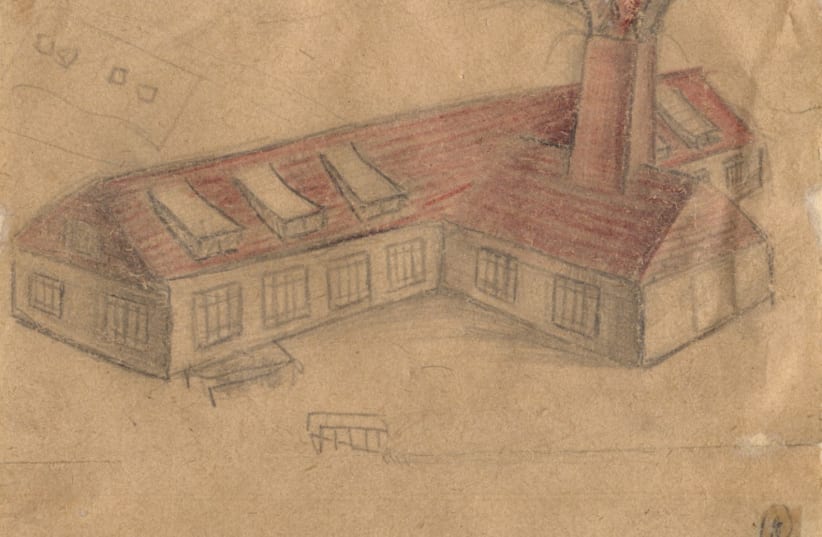The paintings presented to the court during the 1961 trial of SS-Obersturmbannführer Adolf Eichmann, and their role in convicting the Nazi war criminal, will be discussed by Dr. Batya Brutin in an online lecture on Tuesday. One of various online panels hosted by Beit Lohamei Haghetaot to honor International Holocaust Memorial Day.
“Just like a religious person doesn’t leave his phylacteries behind when he needs to leave the house, an artist never walks out the door without a sketchbook and art materials,” Brutin explained. “People painted and sketched in the death camps, in the ghettoes, on the trains used to transport them, and even when they were living in the woods as partisans.”
In addition, the Germans sometimes employed Jewish inmates with artistic skills for their own needs, making unauthorized art was both an act of defiance and an expression of hope that one day, the world will ask how such horrors were committed.
Presented to the court as legal documents, 18 paintings by four painters and one art album containing 20 works in watercolors and ink made by Zofia Rozensztrauch (Naomi Judkowski) were introduced to fully describe the destruction suffered by Jews in occupied Europe.
In the case of Rozensztrach, who was an inmate in Auschwitz from July 1943, the album includes descriptions of how new female inmates (Cugangi in camp slang) were stripped and their hair shaved. She painted the works in Warsaw in 1945 after she was liberated.
The four painters were Leo Haas, Ferdinand (Felix) Bloch, František Mořic Nágel and Yehuda Bacon.
A skilled artist, Hass was forced by the Germans to take part in Operation Bernhard, meant to topple the British economy by forging British bank notes, as depicted in the 2007 film The Counterfeiters. He was able to hide hundreds of paintings in Theresienstadt Ghetto and recover them after the war ended, offering precious evidence to what he and his friends endured.
While the majority of the works were presented in conjunction with survivor’s testimonies and experts discussions, Bacon both presented his own works and offered his own eyewitness account. When he presented his 1945 work, Crematorium II in Auschwitz Birkenau, he added that one of the SS officers took pity on Jewish children one winter and offered them to come near the ovens to warm up.
The Nazis destroyed all five crematoriums in Auschwitz in an attempt to hide their crimes from the world, which is why such paintings are essential to comprehend how the death-camp functioned.
Jews were not the only group brutalized by the Nazis. Dina Babbitt was able to survive Auschwitz because Josef Mengele requested she paint portraits of Romani people for his racial research. Nor were Jewish people the only abused group to produce art during the Second World War. However, the trial focused on the suffering of the Jewish people, and the court proceedings were used to openly talk, on the radio, about a subject most preferred not to discuss at all.
The trial shaped two concepts that left an enduring mark on how the Holocaust was later understood. The first, the “banality of evil,” was coined by Hannah Arendt, who was surprised to discover Eichmann was, she thought, not a demon or a Jew-hating fanatic but “only” a petty bureaucrat.
The other was the testimony of Holocaust writer Yehiel De-Nur (Ka-Tsetnik), who collapsed during his testimony and offered the idea Auschwitz was “on another planet.” An evil so alien and terrible that speaking of it from a “normal” person’s point of view is impossible. De-Nur was one of the few Jewish inmates of Auschwitz who met Eichmann and survived.
A researcher of Holocaust Monuments and Visual Arts in Israel and the world, Brutin is expected to release another study this year about the Auschwitz-inked serial number in Art. The book, under the working title Etched in Flesh and Soul, is expected to be published in Germany and to include works by Max Meier Bueno de Mesquita, Ella Liebermann-Shiber, and Haim Maor.
Mesquita and De-Nur happened to share a therapist, Dr. Jan Bastiaans, who was among the first to use LSD as part of a healing process meant to help Holocaust survivors. Mesquita and Liebermann-Shiber both turned to art as a means to rebuild their lives after the Holocaust.
“The Nazis were unable to destroy this part of their souls,” Brutin pointed out. “When one is painting, even if the pre-Holocaust memories being painted are painful, one feels alive.”
The paintings that helped convict Adolf Eichmann session by former director of Beit Berl College's Holocaust Teaching Program Dr. Batya Brutin will be held online on Tuesday, January 26 at 6 p.m. On Wednesday, Jan 27, at 9 p.m. a discussion about how the Eichmann trial impacted three generations of Israelis will be held in cooperation of Beit Lohamei Haghetaot and the Habima National Theater. A special reading from an upcoming play about the trial will be read by actors. Admission is free.
